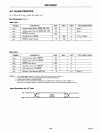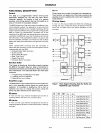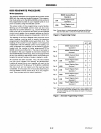
8253/8253·5
OPERATIONAL DESCRIPTION
General
The complete functional definition of the 8253
is
programmed by the systems software. A set
of
control
words must be sent
out
by the CPU to initialize each
counter of the
8253
with the desired MODE and quantity
information. These control words program the
MODE,
Loading sequence and selection of binary or BCD
counting.
Once programmed, the 8253
is
ready
to
perform whatever
M -
MODE:
M2
Ml
MO
0
0 0
Mode
0
0 0
1
Mode
1
X
1
0
Mode
2
X
1 1
Mode
3
1
0
0
Mode
4
1 0
1
Mode
5
timing tasks it
is
assigned to accomplish. BCD:
The actual counting operation of each counter
is
completely independent and additional logic
is
provided
on-chip
so that the usual problems associated with
efficient monitoring and management of external,
asynchronous events
or
rates to the microcomputer
system have been eliminated.
Programming the
8253
All of the MODES
for
each counter are programmed by the
systems software by simple
I/O
operations.
Each counter of the
8253
is
individually programmed by
writing a control word into the Control Word Register.
(AD,
Al =
11)
Control Word Format
0,
DO
SC1
SCO
RL1
MO
BCD
Definition
of
Control
SC
-
Select
Counter:
SCl
SCO
0
0
Select
Counter 0
0
1
Select
Counter 1
1
0
Select
Counter 2
1
1
Illegal
RL - Read/Load:
RLl
RLO
0 0
Counter Latching operation
(see
R EADIWR ITE Procedure Section)
1
0
Read/Load most significant byte only.
0
1 Read/Load
least
significant byte only.
1
1 Read/Load
least
significant byte first,
then most significant byte.
o
Binary Counter 1
&bits
Binary
Coded
Decimal (BCD) Counter
(4
Decades)
Counter
Loading
The
count
register is not loaded
until
the
count
value is
written
(one or
two
bytes, depending on
the
mode
selected by the RL bits), followed by a rising edge and a
falling edge
of
the clock. Any read
of
the
counter
prior
to
that falling
clock
edge may yield invalid data.
MODE
Definition
MODE
0:
Interrupt on Terminal Count. The
output
will
be
initially
low after the mode
set
operation.
After
the
count
is loaded
into
the selected
count
register, the out·
put will remain low and the counter will count. When ter·
minal
count
is reached
the
output
will
go
high and
re-
main high
until
the selected
count
register
is
reloaded
with
the mode or a new
count
is
loaded. The
counter
continues
to
decrement after terminal
count
has been
reached.
Rewriting a counter register during
counting
results in
the following:
(1)
Write 1st byte
stops
the current
counting.
(2)
Write 2nd byte starts the new count.
MODE
1:
Programmable One·Shot. The
output
will
go
low
on the
count
following
the
rising
edge
of
the gate in-
put.
The
output
will
go
high on the terminal
count.
If a new
count
value is loaded
while
the
output
is 10\\1
it
will
not
affect
the duration
of
the one-shot pulse
until
the suc-
ceeding trigger. The current
count
can be read at any
time
without
affecting
the one-shot pulse.
The one-shot is retriggerable, hence the
output
will
re-
main low
for
the full
count
after any rising edge
of
the
gate input.
9-9
AFN-00745A-Q4


















